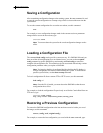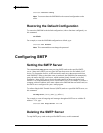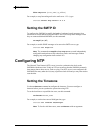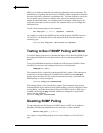
System Administration
TUT Systems, Inc Page 28 of 104 P/N 220-06288-20
Saving a Configuration
After committing configuration changes to the running system, the save command is used
to store the current configuration to a startup script, which is executed the next time the
system boots.
To save the current configuration for use on the next reboot, use this command:
save
For example, to save configuration changes made in the current session to permanent
storage and for use on the next reboot, type:
sms2000% save
Note:
You must reboot the system for the saved configuration changes to take
effect.
Loading a Configuration File
The command load config can be used for system recovery. If a SMS2000 fails and you
have saved the old configuration file to an external server, you can use the set quick-
config command to get the SMS2000 up and running and load config to restore the
complete old configuration file. This minimizes the risk associated with missing a minor
configuration parameter when you replace a SMS2000.
Note:
No integrity checking is performed besides checking the file header. A
corrupt configuration file can be loaded and hang the system. To troubleshoot
possible system failure, use the show startup command.
To load a configuration file from a remote FTP or HTTP server, use this command:.
load config url
Note:
Once the file is loaded, you must reboot the SMS2000 so that the new
configuration takes effect.
For example, to load the configuration file previously saved for the Connie Hotel from an
FTP server, type:
sms2000% load config
ftp://ftp.local.com/Connie_Hotel/config_file
Restoring a Previous Configuration
To restore the SMS2000 configuration to the last one that was active before you saved
the image, use this command:
restore {config | web | original-config}
For example, to restore the last configuration you saved with the save command, type:


















